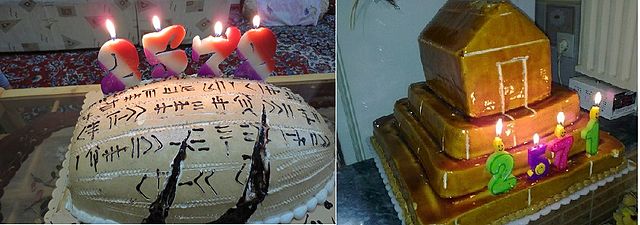The Tomb of Cyrus the Great is the final resting place of Cyrus the Great, the founder of the ancient Achaemenid Empire. The mausoleum is located in Pasargad, an archaeological site in the Fars Province of Iran.
Tomb of Cyrus the Great
The first modern depiction of the tomb, published by James Justinian Morier in 1811, entitled the "Tomb of Madre Suleiman"
Tomb of Cyrus at Pasargadae, where the festivities started.
A cake in the shape of the Cyrus Cylinder and a cake in the shape of the Tomb of Cyrus at Pasargadae
Cyrus II of Persia, commonly known as Cyrus the Great, was the founder of the Achaemenid Persian Empire. Hailing from Persis, he brought the Achaemenid dynasty to power by defeating the Median Empire and embracing all of the previous civilized states of the ancient Near East, expanding vastly and eventually conquering most of West Asia and much of Central Asia to create what would soon become the largest polity in human history at the time. The Achaemenid Empire's largest territorial extent was achieved under Darius the Great, whose rule stretched from the Balkans and the rest of Southeast Europe in the west to the Indus Valley in the east.
"Winged Genius" statue at Pasargadae, with braided hair and a Hemhem crown, traditionally identified as Cyrus
The four-winged guardian figure that may depict Cyrus, known from a bas-relief on a doorway pillar from Pasargadae. An inscription says "I am Cyrus the King, an Achaemenian." Scholars doubting the relief depicts Cyrus note the inscription was inscribed in a later period and that the same inscription is found on other palaces in the complex.
"I am Cyrus the King, an Achaemenian" in Old Persian, Elamite and Akkadian languages. It is known as the "CMa inscription", carved in a column of Palace P in Pasargadae. These inscriptions on behalf of Cyrus were probably made later by Darius I in order to affirm his lineage, using the Old Persian script he had designed.
Painting of king Astyages sending Harpagus to kill young Cyrus








